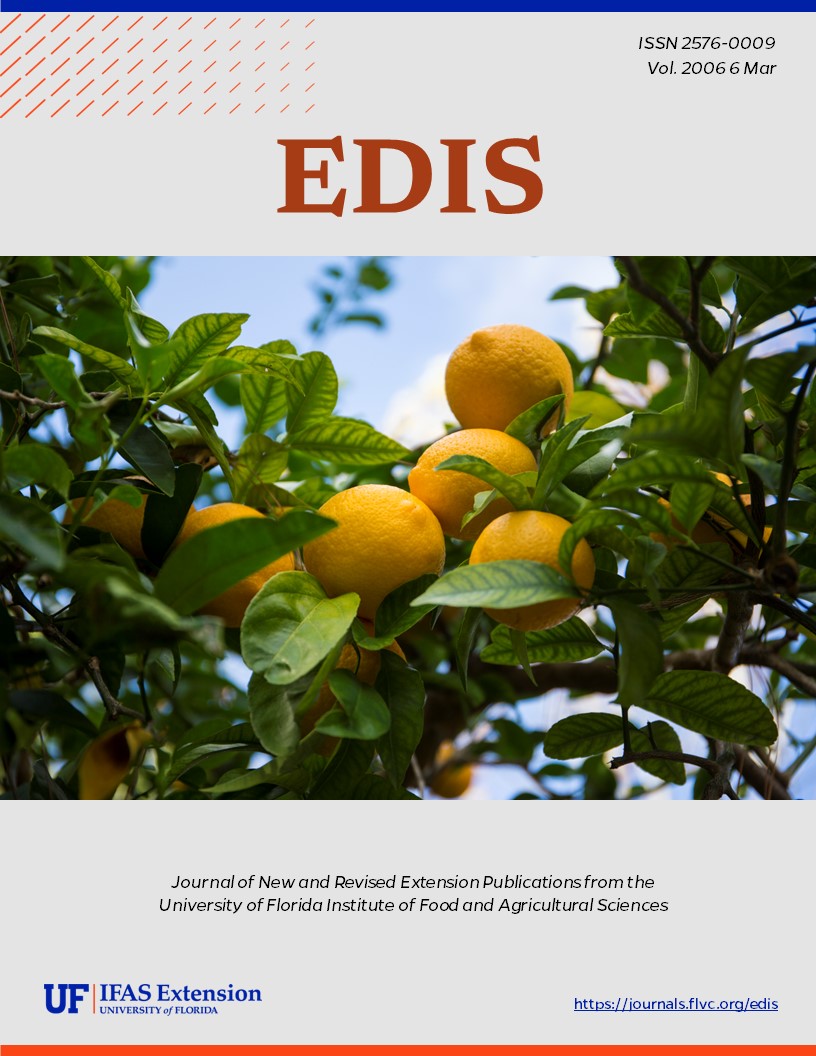Abstract
Arthropod parasites of horses include internal bots that infest the digestive tract, mites that burrow in the skin and feed on the skin surface, ticks that infest the ears as well as the skin, lice that either suck blood or feed on skin, blood sucking flies and mosquitoes that range in size from biting gnats just observable with the naked eye to the large black horse flies which are almost one inch long. Non-biting flies such as house flies and face flies are also important in producing fly worry, irritation and disease transmission. This document is ENY-283 (IG139), one of a series of the Entomology and Nematology Department, UF/IFAS Extension. Original publication date May 1980. Revised March 2006.
References
Broce, A. B. 1988. An improved Alsynite trap for stable flies Stomoxys calcitrans (Diptera: Muscidae). J. Med. Entomol. 25: 406-409. https://doi.org/10.1093/jmedent/25.5.406
Catts, E. P and G. R. Mullen. 2002. Myiasis (Muscoidea, Oestroidea), In: Medical and Veterinary Entomology, (G. R. Mullen and L. A. Durden, Eds.), pp.18-348. Elsevier Science, San Diego, CA. https://doi.org/10.1016/B978-012510451-7/50018-9
George, J. E., R. B. Davey and J. M. Pound. 2002. Introduced ticks and tick-borne diseases: the threat and approaches to eradication. Vet. Clin. Food Anim. 18: 401-416. https://doi.org/10.1016/S0749-0720(02)00030-0
Hogsette, J. A., and J. P. Ruff. 1985. Stable fly (Diptera: Muscidae) migration in Northwest Florida. Environ. Entomol. 14: 170-175. https://doi.org/10.1093/ee/14.2.170
Jones, C. J., J. A. Hogsette, R. S. Patterson, D. E. Milne, G. D. Propp, J. F. Milio, L. G. Rickard and J. P. Ruff. 1991. Origin of stable flies (Diptera: Muscidae) on West Florida beaches: Electrophoretic analysis of dispersal. J. Med. Entomol. 28: 787-795. https://doi.org/10.1093/jmedent/28.6.787
Knapp, F. W. 1985. Arthropod pests of horses. In: Livestock Entomology (R. E. Williams, R. D. Hall, A. B. Broce and P. J. Scholl, eds.), pp. 297-322. Wiley, New York.
Lysyk, T. J. and R. C. Axtell. 1986. Movement and distribution of house flies (Diptera: Muscidae) between habitats in two livestock farms. J. Econ. Entomol. 76: 993-998. https://doi.org/10.1093/jee/79.4.993
Moon, R. D. 2002. Muscoid flies (Muscidae), In: Medical and Veterinary Entomology, (G. R. Mullen and L. A. Durden, Eds.), pp. 45-65. Elsevier Science, San Diego, CA. https://doi.org/10.1016/B978-012510451-7/50016-5
Mullens, B. A. 2002. Horse flies and deer flies (Tabanidae), In: Medical and Veterinary Entomology, (G. R. Mullen and L. A. Durden, Eds.), pp. 264-278. Elsevier Science, San Diego, CA. https://doi.org/10.1016/B978-012510451-7/50015-3
Pickens, L. G., E. T. Schmidtmann and R. W. Miller. 1994. How to control house and stable flies without using pesticides, pp. 1-14. USDA, Washington, DC.
Sonenshine, D. E., R. S. Lane and W. L. Nicholson. 2002. Ticks (Ixodida), In: Medical and Veterinary Entomology, (G. R. Mullen and L. A. Durden, Eds.), pp. 518-558. Elsevier Science, San Diego, CA. https://doi.org/10.1016/B978-012510451-7/50026-8
Steinkraus, D. C., C. J. Geden and D. A. Rutz. 1993. Prevalence of Entomophthora muscae (Cohn) Fresenius (Zygomycetes: Entomophthoraceae) in house flies (Diptera: Muscidae) on dairy farms in New York and induction of epizootics. Biol. Cont. 3: 93-100. https://doi.org/10.1006/bcon.1993.1015

